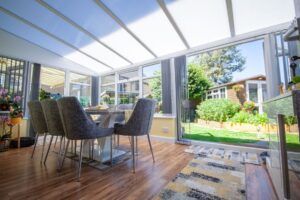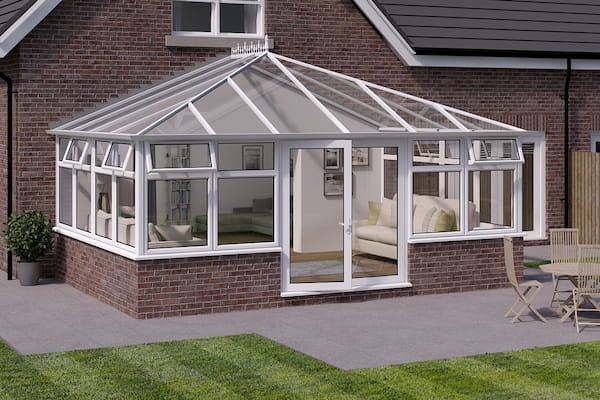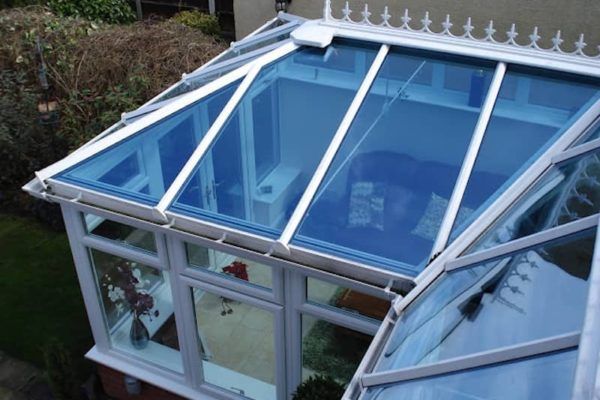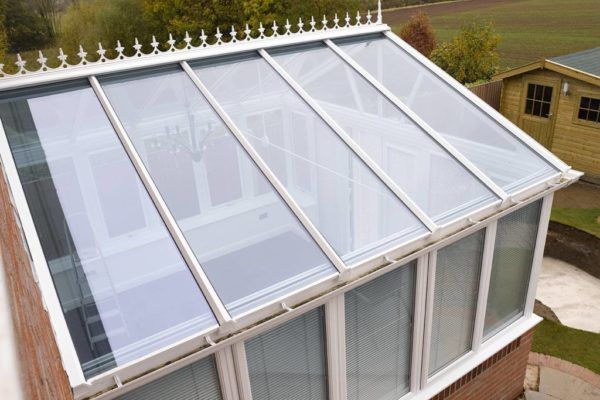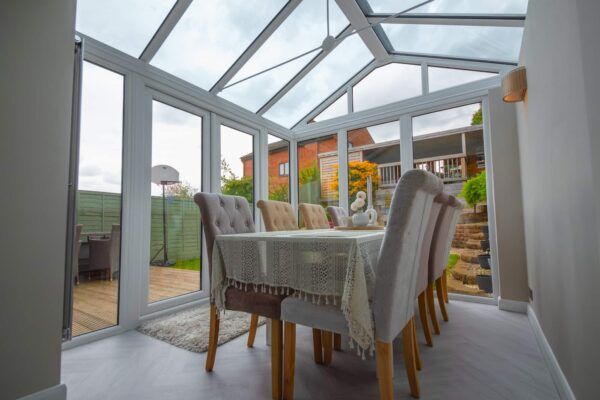When it comes to choosing the right roof for your conservatory, homeowners have several options. Among these, the polycarbonate conservatory roof stands out for its affordability, durability, and versatility.
Polycarbonate roofs — sometimes called polycarbonate glazing or plastic conservatory roofs — are popular options thanks to how strong, lightweight and cost-effective they are.
Below, learn more about the benefits of a polycarbonate roof conservatory, how it compares to other roofing materials, and why it might be the perfect fit for your home.
Polycarbonate roof options
There are several factors to consider when it comes to choosing your polycarbonate conservatory roof.
Thickness
The gaps between the layered sheets of polycarbonate — also known as tunnels — trap warm air, keeping it inside your conservatory. So the more layers you have, the better insulated your space will be.
Our conservatories can be supplied with a multiwall polycarbonate roofing system up to 32mm thick for exceptional energy and sound insulation. Upgrading your plastic roof thickness to 32mm will help keep your room warmer when temperatures drop.
Colour
ConservatoryLand currently offers four distinct polycarbonate colours to choose from:
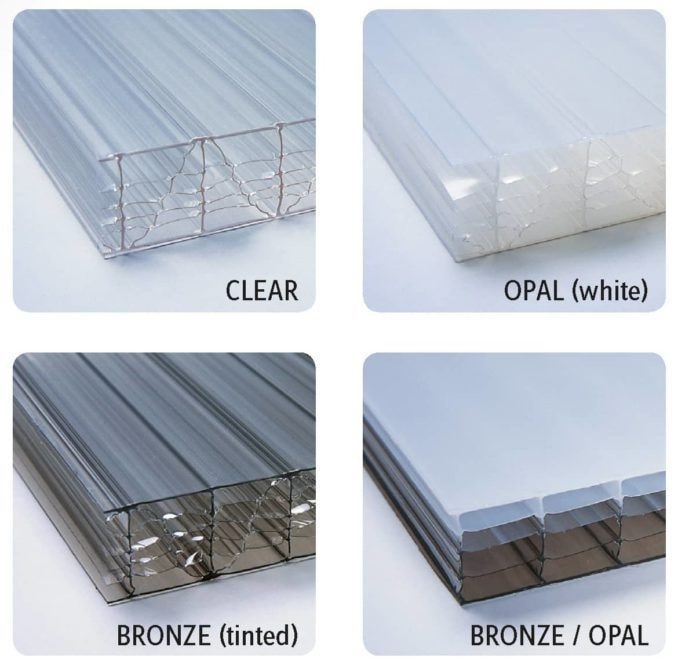
Main benefits of a polycarbonate conservatory roof
Affordability
- One of the primary advantages of opting for a polycarbonate conservatory roof is its cost. Compared to glass or solid roofs, polycarbonate is much more affordable, making it an attractive option for budget-conscious homeowners. You can achieve a stylish and functional conservatory without breaking the bank.
Lightweight yet durable
- Polycarbonate is significantly lighter than glass, reducing the overall load on your conservatory structure. Despite its lightweight nature, it’s incredibly durable, resistant to impact, and can withstand extreme weather conditions, including heavy snow and strong winds.
UV protection
- Polycarbonate roofs often come with a UV-protective layer, helping to filter out harmful rays while still allowing plenty of natural light to flood your conservatory. This feature not only protects your furniture and fittings from fading but also ensures a comfortable and safe environment inside.
Thermal insulation
- Polycarbonate roofing provides excellent thermal insulation, keeping your conservatory warmer in the winter and cooler in the summer. This energy efficiency can lead to lower heating and cooling costs, making your conservatory a comfortable space to use all year round.
Versatility
- Available in a range of colours, thicknesses, and finishes, polycarbonate roofs can be customised to match the aesthetic of your home. Whether you prefer a clear, opal, or bronze finish, there’s a polycarbonate solution that will complement your design vision.
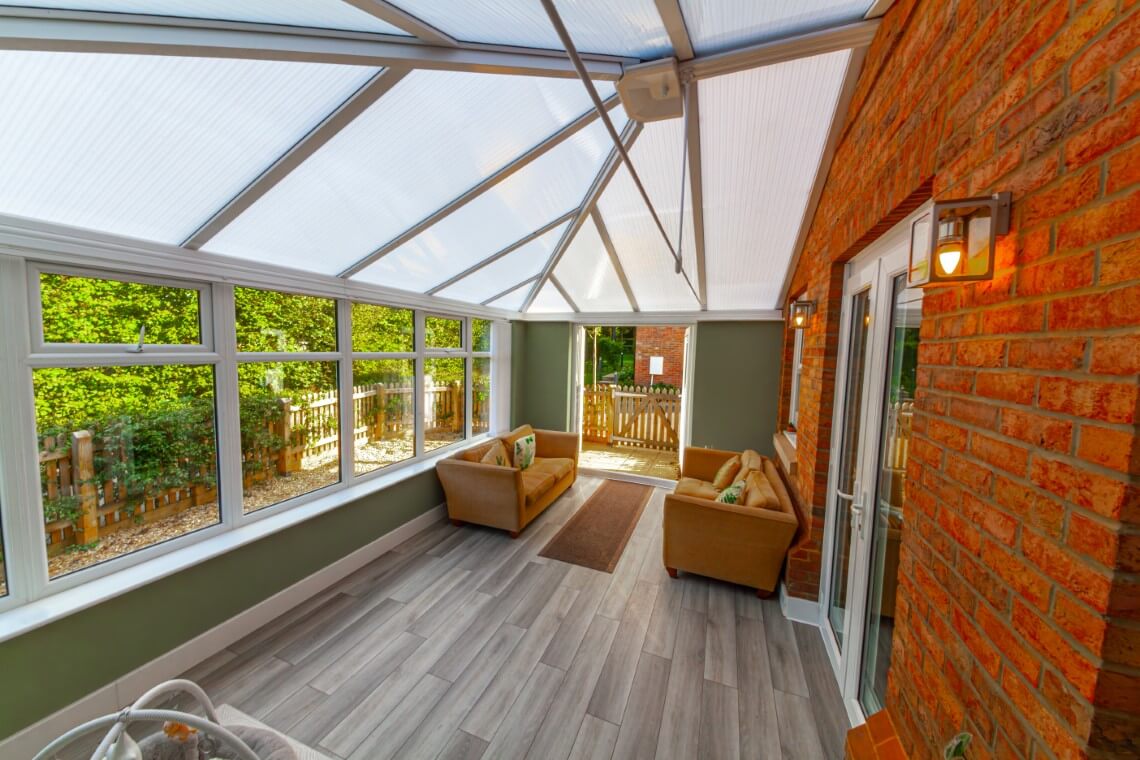
Polycarbonate vs. Glass: How do they compare?
While both polycarbonate and glass are popular choices for conservatory roofs, there are key differences:
- Cost: Polycarbonate is generally less expensive than glass, making it a more budget-friendly option.
- Weight: Polycarbonate is much lighter than glass, which can be advantageous in terms of installation and structural requirements.
- Durability: Polycarbonate is more impact-resistant than glass, which can shatter under certain conditions.
- Light transmission: Glass typically offers clearer, more natural light transmission, while polycarbonate may have a slight tint, depending on the type.
- Aesthetics: Glass roofs are often considered more aesthetically pleasing, offering unobstructed views of the sky, but polycarbonate roofs are still highly versatile and can be designed to look modern and sleek.
FAQs
What is polycarbonate roofing?
Polycarbonate roofing, often referred to as a plastic conservatory roof, is a type of roofing material made from polycarbonate, a durable, lightweight plastic known for its impact resistance and versatility.
Polycarbonate panels are available in various thicknesses and finishes, such as clear, tinted, or opaque, allowing for different levels of light transmission and privacy. This type of roofing is popular due to its affordability, UV protection, thermal insulation properties, and ability to withstand harsh weather conditions.
How long does a polycarbonate roof last on a conservatory?
A polycarbonate roof on a conservatory typically lasts between 10 to 20 years, depending on factors such as the quality of the polycarbonate, installation, and maintenance. High-quality polycarbonate panels with UV protection tend to have a longer lifespan and maintain their clarity and performance better over time.
For more detailed information on guarantees and the expected lifespan of different roofing materials, including polycarbonate, visit our guarantees page. This resource provides insights into the warranty coverage and expected durability of our products.
Does it get hot under a polycarbonate roof?
Polycarbonate roofs, while providing good insulation and UV protection, can sometimes allow more heat to build up compared to other materials like glass. However, many modern polycarbonate roofs are designed with advanced thermal insulation properties to mitigate this effect.
To help manage the temperature, polycarbonate roofs often come with features such as multi-wall panels or reflective coatings that reduce heat buildup.
Can you walk on a polycarbonate conservatory roof?
No, you should not walk on a polycarbonate conservatory roof. While polycarbonate is durable and impact-resistant, it is not designed to support the weight of a person walking on it. Doing so can damage the panels or compromise the integrity of the roof.
For cleaning and maintaining your polycarbonate conservatory roof safely, please refer to our guide on how to clean a conservatory roof.
Polycarbonate conservatory roof prices
One of the main advantages of polycarbonate roofs is that they cost less than glass styles, ideal if you’re working with a strict budget. The two factors most likely to impact the overall polycarbonate roof conservatory price are the type of build you choose, and its size.
As a general rule of thumb, the larger the roof area, the more the polycarbonate will cost. If the roof style is more ornate or complex in its shape, it might also affect the price. A simple polycarbonate Lean-to roof, for example, will likely be one of the more cost-effective options, while a larger Edwardian style could be more expensive.
Need some more inspiration? Download a free brochure today and explore the range of styles and customisation options available. Plus, with our quote engine, you can easily compare prices based on your specific requirements. Simply input your details to receive a customised quote, helping you determine the best roofing option for your budget.
